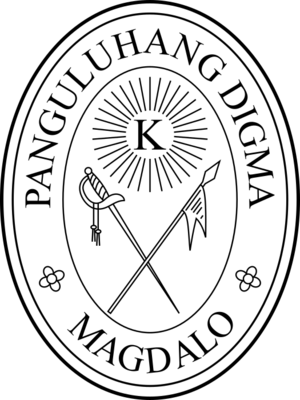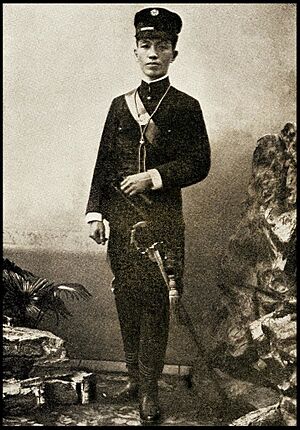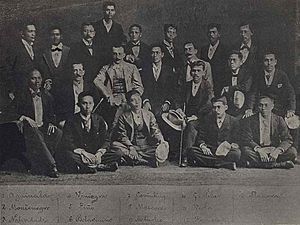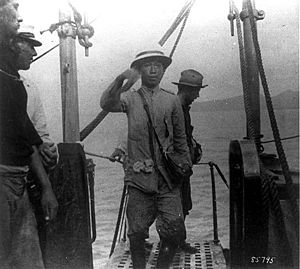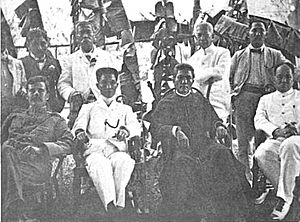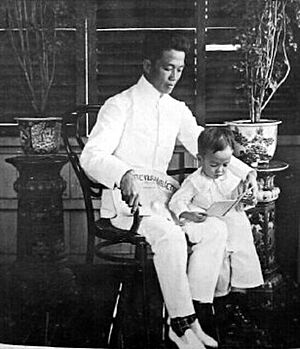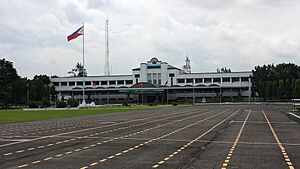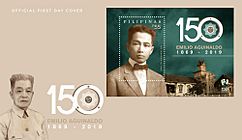Emilio Aguinaldo facts for kids
Quick facts for kids
Emilio F. Aguinaldo
|
|
|---|---|
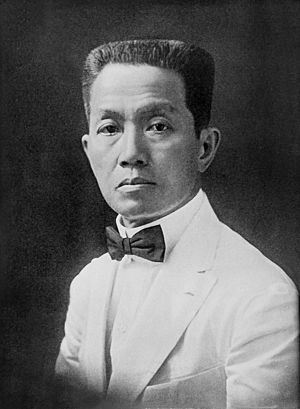
Aguinaldo in 1919
|
|
| 1st President of the Philippines | |
| In office January 23, 1899 – March 23, 1901 |
|
| Prime Minister |
|
| Vice President | Mariano Trias (1897 de facto) |
| Preceded by | Position established Diego de los Ríos (as Governor-General of the Philippines) |
| Succeeded by | Position abolished Manuel L. Quezon |
| President of the Revolutionary Government of the Philippines | |
| In office June 23, 1898 – January 22, 1899 |
|
| Prime Minister |
|
| Preceded by | Position established |
| Succeeded by | Position abolished (Revolutionary government superseded by the First Philippine Republic) |
| Commanding General of the Philippine Revolutionary Army | |
| In office June 5, 1899 – March 23, 1901 |
|
| President | Himself |
| Preceded by | Antonio Luna |
| Dictator of the Philippines | |
| In office May 24, 1898 – June 23, 1898 |
|
| Preceded by | Position established |
| Succeeded by | Position abolished (Dictatorial government replaced by a revolutionary government with Aguinaldo assuming the title president) |
| President of the Republic of Biak-na-Bato | |
| In office November 2, 1897 – December 14, 1897 |
|
| Vice President | Mariano Trías |
| Preceded by | Position established |
| Succeeded by | Position abolished |
| President of the Tejeros Revolutionary Government | |
| In office March 22, 1897 – November 1, 1897 |
|
| Vice President | Mariano Trías |
| Preceded by | Position established |
| Succeeded by | Position abolished (Tejeros government superseded by the Republic of Biak-na-Bato) |
| Personal details | |
| Born |
Emilio Aguinaldo y Famy
March 22, 1869 Cavite el Viejo, Cavite, Captaincy General of the Philippines, Spanish Empire |
| Died | February 6, 1964 (aged 94) Quezon City, Philippines |
| Resting place | Emilio Aguinaldo Shrine, Kawit, Cavite, Philippines |
| Political party | National Socialist (1935–1936) Independent (until 1935) |
| Spouses |
Hilaria del Rosario
(m. 1896; died 1921)María Agoncillo
(m. 1930; died 1963) |
| Children | 5 (see below) |
| Alma mater | Colegio de San Juan de Letran |
| Profession | Statesman Military leader |
| Awards | Philippine Legion of Honor Quezon Service Cross Presidential Medal of Merit Order of the Knights of Rizal |
| Signature | |
| Nicknames | "Kapitan Miong" "Heneral Miong" "Ka Miong" "El Caudillo" "Magdalo" "Hermano Colon" |
| Military service | |
| Allegiance | |
| Branch/service | |
| Years of service | 1896–1901 |
| Rank | |
| Battles/wars |
|
| Footnotes: |
|
Emilio Aguinaldo y Famy QSC CCLH PMM KGCR (March 22, 1869 – February 6, 1964) was a Filipino leader. He was a revolutionary, a statesman, and a military general. He is known as the youngest and first president of the Philippines (1899–1901). He was also the first president of a constitutional republic in Asia.
Aguinaldo led Filipino forces in three major conflicts. First, he fought against Spain in the Philippine Revolution (1896–1898). Then, he led forces during the Spanish–American War (1898). Finally, he fought against the United States in the Philippine–American War (1899–1901).
Some people consider him a national hero of the Philippines. However, his actions during the revolution and World War II have also been debated by historians.
Contents
- Emilio Aguinaldo's Early Life
- The Philippine Revolution Begins
- Return to the Philippines and Independence
- The First Philippine Republic
- Life During the American Era
- World War II and Later Life
- Independence Era and Legacy
- Personal Life
- Death and Legacy
- Honors and Recognition
- Commemoration
- Written Works
- Portrayals in Film
- See also
Emilio Aguinaldo's Early Life
Emilio Aguinaldo y Famy was born on March 22, 1869. His birthplace was Cavite el Viejo, which is now Kawit, in the province of Cavite. His parents were Carlos Aguinaldo y Jamir and Trinidad Famy y Villanueva. Emilio was the seventh of their eight children.
His family was well-off. His father, Carlos, was the local municipal governor (called gobernadorcillo) under Spanish rule. Emilio studied at Colegio de San Juan de Letran. However, he could not finish his studies because of a cholera outbreak in 1882.
In 1895, at age 25, Aguinaldo became the first municipal governor-captain (gobernadorcillo capitan municipal) of Cavite el Viejo.
The Philippine Revolution Begins
On January 1, 1895, Aguinaldo joined the Freemasons. He used the codename "Colon."
On March 7, 1895, he was encouraged to join the "Katipunan." This was a secret group led by Andrés Bonifacio. Its goal was to remove the Spanish rulers and gain independence for the Philippines through armed force. Aguinaldo joined and used the name Magdalo in honor of Mary Magdalene. The local Katipunan group in Cavite was called Sangguniang Magdalo. Aguinaldo's cousin, Baldomero Aguinaldo, became its leader.
The Philippine Revolution against Spain started in late August 1896 in San Juan del Monte. Aguinaldo and other rebels in Cavite did not join at first because they lacked weapons. Bonifacio's rebels used guerrilla warfare. However, Aguinaldo and the Cavite rebels won big victories in planned battles. They temporarily drove the Spanish out of their area.
On August 31, 1896, Aguinaldo began the Kawit Revolt. He marched with his army to the town center of Kawit. He had told his men not to harm anyone in his hometown. The Spanish guards were surprised and surrendered quickly. The rebels captured their guns. This revolt was a great success for Aguinaldo. Later that day, they raised the Magdalo flag at the town hall. Many people from Kawit gathered to celebrate their town's freedom.
The Magdalo group used flags with a white sun and a red baybayin symbol for Ka. This flag became the first official flag of the revolutionary forces. It was blessed in Imus. Aguinaldo spoke about this flag in his message on October 31, 1896. He said, "Filipino people!! The hour has arrived to shed blood for the conquest of our liberty. Assemble and follow the flag of the Revolution – it stands for Liberty, Equality and Fraternity."
Winning Battles in Cavite
In August 1896, the revolution spread from Manila. Aguinaldo marched from Kawit with 600 men. He started skirmishes in Imus that turned into open fighting against Spanish troops. On September 1, with help from Captain Jose Tagle, they surrounded Imus. This was to make the Spanish come out.
A Spanish relief force came from Manila to help. Aguinaldo's men fought back but lost many soldiers. The Spanish general, Ernesto de Aguirre, went back to Manila for more troops. Aguinaldo's troops got ready for another attack. On September 3, Aguirre returned with 3,000 men. When the Spanish troops reached the Isabel II Bridge, rebels hidden nearby fired at them. The Spanish were defeated and retreated with many casualties. Aguinaldo took Aguirre's sword, which he carried in future battles.
The Spanish governor, Ramón Blanco y Erenas, was worried by Aguinaldo's victories. He sent more troops from Spain and Cuba to stop the rebellion in Cavite. Spanish ships also attacked revolutionary forts along the coast.
The most important battles were the Battles of Binakayan-Dalahican in November 1896. Filipino rebels, led by Aguinaldo and General Santiago Alvarez, successfully defended their positions. They forced the Spanish back to Cavite City. These victories were seen as the first major wins for Filipinos against a colonial power.
In February 1897, the new Spanish governor, Camilo de Polavieja, launched a big attack on Cavite. He ordered General José de Lachambre to attack from the rear, while he attacked from the front. At the Battle of Zapote Bridge, Aguinaldo's soldiers planted dynamite and sharp bamboo sticks. When 12,000 Spanish soldiers crossed the bridge, the dynamite exploded. Many Spanish troops died or were injured. The rebels fought hand-to-hand and pushed back the enemy. Edilberto Evangelista was killed in this battle.
Cavite became a key area for the revolution. Aguinaldo's forces continued to win battles.
The Tejeros Convention
There was conflict between different groups within the Katipunan, especially between the Magdalo and Magdiwang factions. This led to a meeting in Tejeros, Cavite, on March 22, 1897. Andrés Bonifacio led the meeting.
At this meeting, Aguinaldo was elected president of the new revolutionary government. He was not there because he was busy fighting in Imus. Mariano Trias was elected vice-president. Bonifacio was elected director of the interior, but his qualifications were questioned. Bonifacio was upset and declared the meeting dissolved and its results invalid.
However, Aguinaldo secretly went to Malabon (now Tanza, Cavite). On the evening of March 23, he took an oath to become the Generalissimo (Commander-in-Chief) of the Philippine Islands.
Peace and Exile in Hong Kong
The Spanish army continued to attack, forcing Aguinaldo's forces to retreat. On June 24, 1897, Aguinaldo set up his headquarters at Biak-na-Bato in San Miguel, Bulacan. In October 1897, he formed an assembly of generals. They decided to create a constitutional republic. A constitution was written, and Aguinaldo was named president.
The Spanish Governor-General, Fernando Primo de Rivera, 1st Marquis of Estella, wanted a peaceful solution. A lawyer named Pedro Paterno met with Aguinaldo to discuss peace. After several months of talks, Aguinaldo signed the Pact of Biak-na-Bato on December 14–15, 1897. In this agreement, Aguinaldo agreed to stop fighting and dissolve his government. In return, he would receive amnesty and ₱800,000 (Mexican pesos) as payment.
On December 23, Aguinaldo and other revolutionary leaders went to Hong Kong for voluntary exile. The first payment of MXN$400,000 was put into Hong Kong banks. While in exile, Aguinaldo reorganized his government into the "Hong Kong Junta."
Return to the Philippines and Independence
On April 25, 1898, the Spanish–American War began. The US Navy's Asiatic Squadron, led by Commodore George Dewey, sailed to the Philippines. On May 1, 1898, in the Battle of Manila Bay, Dewey's squadron destroyed the Spanish fleet. They then blocked Manila.
A few days later, Dewey agreed to bring Aguinaldo from Hong Kong back to the Philippines. Aguinaldo arrived in Cavite on May 19. He quickly took command of the revolutionary forces again and surrounded Manila.
Dictatorial Government and Flag Day
Aguinaldo had a plan for a federal republic. However, on May 24, 1898, he declared a dictatorial government in Cavite. He became the dictator and had full power to issue decrees. This government was temporary until peace and freedom were achieved.
On May 28, 1898, Aguinaldo led about 18,000 troops against a small Spanish group in Alapan, Imus, Cavite. The battle lasted for five hours. After winning, Aguinaldo proudly unfurled the Philippine flag for the first time. He raised it at the Teatro Caviteño in Cavite Nuevo (now Cavite City). Filipino revolutionaries and American sailors watched. Flag Day is celebrated every May 28 to remember this important battle.
Declaring Independence and Forming a Republic
On June 12, 1898, Aguinaldo officially declared the Philippine Declaration of Independence from Spain. This happened at his own home in Cavite El Viejo. He hoped this declaration would inspire Filipinos to fight against the Spanish.
On June 18, he issued a decree to formally establish his dictatorial government. This decree also organized local governments and created the Revolutionary Congress.
On June 23, Aguinaldo changed his dictatorial government to a revolutionary government. He became president. This was based on the advice of his advisor, Apolinario Mabini. This change prepared the way for the government to become a republic.
Arrival of American Forces
By May 1898, Filipino troops had removed Spanish forces from Cavite. By late June 1898, Aguinaldo, with help from American allies, prepared to drive the Spanish out of Manila. American troops started arriving in Cavite in June and July. By then, 12,000 US troops were in the Philippines.
Aguinaldo offered surrender terms to the Spanish Governor-General, Basilio Augustín. Augustín refused at first, hoping for more Spanish troops. But as Filipino and American forces closed in, he realized his situation was hopeless. He secretly tried to negotiate with Aguinaldo, even offering ₱1 million, but Aguinaldo refused. The Spanish government was angry and replaced Augustín with Fermin Jáudenes.
In August 1898, life in Intramuros, the walled city of Manila, was very difficult. Jáudenes suggested to Dewey that the city surrender to the Americans after a short, "mock" battle. He feared what might happen if the city fell to Filipino revolutionaries. Dewey agreed. The plan was for a bloodless battle. However, Spanish troops opened fire, and Filipino revolutionaries joined in, thinking it was a real attack. Six Americans and forty-nine Spaniards died. The city surrendered to the Americans, not to the Filipinos. The Filipinos felt betrayed.
By late September, Aguinaldo's forces had captured over 9,000 Spanish prisoners. They were generally free but remained under Aguinaldo's control. Aguinaldo did not know that on December 10, 1898, the Treaty of Paris was signed. This treaty transferred the Philippines from Spain to the United States for $20 million.
The First Philippine Republic
The First Philippine Republic was officially formed when the Malolos Constitution was declared on January 21, 1899, in Malolos, Bulacan. This republic lasted until Aguinaldo was captured by American forces on March 23, 1901. His capture effectively ended the First Republic.
On February 4, 1899, an American soldier shot a Filipino. This event is considered the start of the Philippine–American War. The Battle of Manila then broke out between American and Filipino forces. The Americans had better technology and pushed Filipino troops out of the city. Aguinaldo's government had to move from place to place. At the Battle of Marilao River, Aguinaldo himself led his forces. The Americans won only after tough fighting and using gunboats.
On November 13, 1899, Aguinaldo changed his strategy. He disbanded the regular Filipino army and decided to use guerrilla warfare. Aguinaldo led the resistance against the Americans but retreated to Northern Luzon.
Aguinaldo's Capture
On March 23, 1901, American forces, with the help of Macabebe Scouts, captured Aguinaldo at his headquarters in Palanan, Isabela. On April 19, 1901, Aguinaldo took an oath of loyalty to the United States. This officially ended the First Republic and recognized American rule over the Philippines. After Aguinaldo's capture, some Filipino commanders continued to fight, like General Macario Sakay.
Life During the American Era
During the American period (1898–1946), Aguinaldo mostly stayed out of public life. However, he continued to support groups that wanted immediate independence for the Philippines. He also helped veterans of the revolution. He created the Asociación de los Veteranos de la Revolución (Association of Veterans of the Revolution) to help them get pensions and buy land.
In 1907, a law made it illegal to display the Philippine flag. But this law was changed on October 30, 1919. After that, Aguinaldo turned his home in Kawit into a monument to the flag, the revolution, and the Declaration of Independence. After his death, the government made his mansion a National Shrine in June 1964.
1935 Presidential Election

In 1935, the Philippines became a commonwealth. This was a step towards full independence. Presidential elections were held. Aguinaldo returned to public life and ran for president. He was the candidate for the National Socialist Party. He ran against the very popular Manuel L. Quezon.
Aguinaldo lost the election by a large margin. He only got 17.5% of the votes. Some people did not support him because of his past actions, such as his surrender to the Americans in 1901.
Aguinaldo did not accept the election results. He believed they were rigged. In Cavite, his supporters planned a rally in Manila to disrupt Quezon's inauguration. This plan was never carried out. Aguinaldo continued to criticize Quezon. The two leaders later reconciled in 1941. Quezon moved Flag Day to June 12 to celebrate the Philippine independence proclamation.
World War II and Later Life
On December 8, 1941, the Imperial Japanese Army invaded the Philippines. Aguinaldo had admired Japan for a long time. He believed Japan would free the Philippines from American rule. So, he sided with the Japanese. In January 1942, he met with a Japanese general to discuss a pro-Japanese government. On February 1, Aguinaldo spoke on the radio, asking American and Filipino troops to surrender to the Japanese.
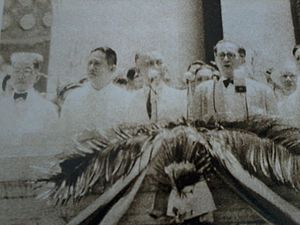
Aguinaldo continued to work with the Japanese after American forces retreated. He was part of a committee that created a new constitution for a Japanese-backed government in the Philippines. He also urged Filipino fighters to stop resisting the Japanese. Aguinaldo was present at the inauguration of the Second Philippine Republic on October 14, 1943. The Japanese considered making him president, but they chose Jose P. Laurel instead. Aguinaldo was appointed head of a company that rationed goods for the Japanese war effort.
After US forces returned to the Philippines in October 1944, Aguinaldo went into hiding. He was arrested on February 8, 1945. The US Army investigated his actions during the war. Aguinaldo claimed he had secretly remained loyal to the US. He said he and others were forced to work with Japan. He believed they should be granted amnesty. However, he was accused of supporting and working with the Japanese.
Aguinaldo was 77 when the US government recognized Philippine independence on July 4, 1946. On January 28, 1948, Philippine president Manuel Roxas granted amnesty to Filipinos who had worked with Japan. As a result, the accusations against Aguinaldo were dropped, and his trial was never held.
Independence Era and Legacy
In 1950, President Elpidio Quirino appointed Aguinaldo to the Philippine Council of State. He served a full term. Afterward, he retired again and focused on helping veteran soldiers.
The University of the Philippines gave him an honorary Doctor of Laws degree in 1953.
On May 12, 1962, President Diosdado Macapagal changed the celebration of Independence Day from July 4 to June 12. This was to honor Aguinaldo and the Revolution of 1898. Aguinaldo, though in poor health, attended the observances that year. On August 4, 1964, June 12 was officially declared Philippine Independence Day.
Personal Life
On January 1, 1896, Emilio Aguinaldo married Hilaria del Rosario (1877–1921). They had five children: Carmen, Emilio Jr., Maria, Cristina, and Miguel. Hilaria passed away in 1921.
Nine years later, on July 14, 1930, Aguinaldo married Maria Agoncillo (1879–1963). She passed away in 1963, a year before Aguinaldo.
Some of his grandchildren and great-grandchildren have also served in public office in the Philippines. One of his great-grandsons, Emilio "Orange" M. Aguinaldo IV, married news reporter Bernadette Sembrano in 2007.
During the revolution, Aguinaldo supported the Philippine Independent Church. Later in life, he returned to Roman Catholicism.
Death and Legacy
Aguinaldo was taken to Veterans Memorial Medical Center in Quezon City on October 5, 1962. He stayed there for 469 days. He died on February 6, 1964, from a heart condition, one month before his 95th birthday. A year before he died, he gave his land and mansion to the government. This property is now a shrine to remember the Revolution of 1896.
In 1964, he published his book, Mga Gunita ng Himagsikan (Memoirs of the Revolution). A second edition was released in 1998 during the 100th anniversary of Philippine Independence.
Many people consider Aguinaldo a very important figure in Philippine history. He played a key role in the Philippine Revolution's victory against Spain and in the fight for independence.
Honors and Recognition
 : Quezon Service Cross – (June 12, 1956)
: Quezon Service Cross – (June 12, 1956) : Philippine Legion of Honor, Chief Commander – (1957)
: Philippine Legion of Honor, Chief Commander – (1957) : Presidential Medal of Merit – (July 2, 1955)
: Presidential Medal of Merit – (July 2, 1955) : The Order of the Knights of Rizal, Knight Grand Cross of Rizal - KGCR.
: The Order of the Knights of Rizal, Knight Grand Cross of Rizal - KGCR.
Commemoration
- In 1935, Camp Aguinaldo was established as the military general headquarters of the Armed Forces of the Philippines. It was named after Aguinaldo.
- In 1957, Emilio Aguinaldo College was founded and named after him.
- In 1965, President Diosdado Macapagal signed a law renaming the parish of Bailen, Cavite, to General Emilio Aguinaldo.
- In 1985, BRP General Emilio Aguinaldo was launched as a patrol vessel for the Philippine Navy.
- In 1985, the Aguinaldo Museum was opened in Baguio.
- In 1985, the Bangko Sentral ng Pilipinas issued a new 5-peso bill with Aguinaldo's portrait. Later, a ₱5.00 coin also featured his profile. In 2017, Andres Bonifacio replaced Aguinaldo on the 5-peso coin.
- In 1999, Aguinaldo International School Manila was established.
- In 2019, President Rodrigo Duterte declared March 22, 2019, as "Emilio Aguinaldo Day" to celebrate his birth anniversary.
- The Aguinaldo Highway is a major road in Cavite.
- Aguinaldo Hill in Allaguia was used as a post by Aguinaldo during the Philippine–American War.
Written Works
- Resena veridica de la revolución filipina, 1899
- Mga Gunita ng Himagsikan, 1964
- My Memoirs, 1967
Portrayals in Film
Emilio Aguinaldo has been played by various actors in films about the Philippine Revolution:
- 1926 – Charles Stevens in Across the Pacific
- 1993 – Mike Lloren in Sakay
- 1996 – Raymond Alsona in Bayani
- 1997 – Joel Torre in Tirad Pass: The Story of Gen. Gregorio del Pilar
- 2008 – Johnny Solomon in Baler
- 2010 – Lance Raymundo in Ang Paglilitis ni Andres Bonifacio
- 2010 – Dennis Trillo in the "Lupang Hinirang" music video
- 2011 – Carlos Morales in Watawat
- 2012 – Jericho Ejercito and E.R. Ejercito in El Presidente
- 2013 – Nico Antonio in Katipunan
- 2014 – Jun Nayra in Bonifacio: Ang Unang Pangulo
- 2015 – Mon Confiado in Heneral Luna and its 2018 sequel Goyo: The Boy General
- 2018 – Gonzalo Gonzalez in Quezon's Game
- 2018 – Jolo Revilla in Agosto Uno, Kasaysayang Nakalimutan (a documentary)
See also
 In Spanish: Emilio Aguinaldo para niños
In Spanish: Emilio Aguinaldo para niños
- Rizal Day
- Tagalog people


